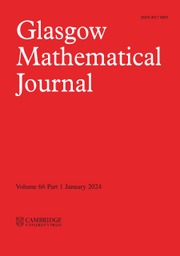Crossref Citations
This article has been cited by the following publications. This list is generated based on data provided by Crossref.
Askey, Richard
and
Gasper, George
1972.
Certain Rational Functions Whose Power Series Have Positive Coefficients.
The American Mathematical Monthly,
Vol. 79,
Issue. 4,
p.
327.
Menegatto, V. A.
and
Piantella, A. C.
2010.
Convergence for Summation Methods with Multipliers on the Sphere.
Numerical Functional Analysis and Optimization,
Vol. 31,
Issue. 6,
p.
738.
Fakhar-Izadi, Farhad
and
Dehghan, Mehdi
2014.
Space–time spectral method for a weakly singular parabolic partial integro-differential equation on irregular domains.
Computers & Mathematics with Applications,
Vol. 67,
Issue. 10,
p.
1884.
Fantuzzi, Giovanni
and
Wynn, Andrew
2016.
Semidefinite relaxation of a class of quadratic integral inequalities.
p.
6192.
Fantuzzi, G.
and
Wynn, A.
2016.
Optimal bounds with semidefinite programming: An application to stress-driven shear flows.
Physical Review E,
Vol. 93,
Issue. 4,
Fantuzzi, Giovanni
Wynn, Andrew
Goulart, Paul J.
and
Papachristodoulou, Antonis
2017.
Optimization With Affine Homogeneous Quadratic Integral Inequality Constraints.
IEEE Transactions on Automatic Control,
Vol. 62,
Issue. 12,
p.
6221.
Fakhar-Izadi, Farhad
and
Dehghan, Mehdi
2018.
Modal spectral element method in curvilinear domains.
Applied Numerical Mathematics,
Vol. 128,
Issue. ,
p.
157.
Švarc, A.
Wunderlich, Y.
Osmanović, H.
Hadžimehmedović, M.
Omerović, R.
Stahov, J.
Kashevarov, V.
Nikonov, K.
Ostrick, M.
Tiator, L.
and
Workman, R.
2018.
Connection between angle-dependent phase ambiguities and the uniqueness of the partial-wave decomposition.
Physical Review C,
Vol. 97,
Issue. 5,
Švarc, A.
Osmanović, H.
Hadžimehmedović, M.
Omerović, R.
Stahov, J.
Gorchteyn, M.
Kashevarov, V.
Nikonov, K.
Ostrick, M.
and
Tiator, L.
2018.
Role of angle-dependent phase rotations of reaction amplitudes in
η
photoproduction on protons.
Physical Review C,
Vol. 98,
Issue. 4,
Nie, Yinyu
Tang, Zhao
Liu, Fengjia
Chang, Jian
and
Zhang, Jianjun
2018.
A data-driven dynamics simulation framework for railway vehicles.
Vehicle System Dynamics,
Vol. 56,
Issue. 3,
p.
406.
Ragan, Robert J
and
Barnes, Eric I
2019.
Predicting steady states of one-dimensional collisionless gravitating systems.
Monthly Notices of the Royal Astronomical Society,
Vol. 487,
Issue. 3,
p.
3618.
Barnes, Eric I
and
Ragan, Robert J
2019.
Relaxation of one-dimensional collisionless gravitating systems.
Monthly Notices of the Royal Astronomical Society,
Vol. 487,
Issue. 3,
p.
3037.
Ben-Ami, Y.
and
Manela, A.
2021.
Acoustic levitation of a rigid nano-sphere at non-continuum conditions.
Journal of Fluid Mechanics,
Vol. 916,
Issue. ,
Bangun, Arya
Behboodi, Arash
and
Mathar, Rudolf
2021.
Tight bounds on the mutual coherence of sensing matrices for Wigner D-functions on regular grids.
Sampling Theory, Signal Processing, and Data Analysis,
Vol. 19,
Issue. 2,
Weiss, A. J.
Nieves‐Chinchilla, T.
Möstl, C.
Reiss, M. A.
Amerstorfer, T.
and
Bailey, R. L.
2022.
Writhed Analytical Magnetic Flux Rope Model.
Journal of Geophysical Research: Space Physics,
Vol. 127,
Issue. 12,
Calderón-Barreto, Elkinn A.
and
Aragón, José L.
2022.
Turing patterns with space varying diffusion coefficients: Eigenfunctions satisfying the Legendre equation.
Chaos, Solitons & Fractals,
Vol. 165,
Issue. ,
p.
112869.
Djellouli, Rabia
Klein, David
and
Levy, Matthew
2024.
Legendre expansions of products of functions with applications to nonlinear partial differential equations.
Applied Numerical Mathematics,
Vol. 201,
Issue. ,
p.
301.
Zhang, Nan
and
Lu, Ya Yan
2024.
Spectral Galerkin mode-matching method for applications in photonics.
Physical Review E,
Vol. 109,
Issue. 5,


